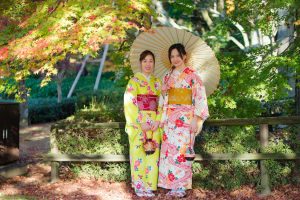Traditional Japanese attire has captivated the world with its elegance, intricate designs, and cultural significance. Two garments that often pique curiosity are the yukata and the kimono. Although they may seem similar at first glance, each has unique features and historical contexts that set them apart. In this blog post, we will explore the differences between yukata and kimono, their evolution, and how they fit seamlessly into modern lifestyles.
What is a Kimono?
The kimono is a traditional Japanese garment worn by both men and women. Historically, kimonos were reserved for formal events such as weddings, tea ceremonies, and other important occasions. These garments are typically made from silk and come in a variety of colors and patterns, often signifying the wearer’s age, marital status, and season.
Key Features of a Kimono:
- Material: Typically made from silk, modern kimono are often made of cotton
- Formality: Traditionally worn for formal events
- Design: Intricate patterns and designs
- Occasions: Weddings, tea ceremonies, and formal gatherings
Kimonos have evolved and are now also worn to casual events and even for lounging. The modern kimono can be found in various materials, including cotton, making them more accessible and easier to care for.
What is a Yukata?
The yukata is a more casual version of the kimono, initially worn at bathhouses and for lounging at home. Made from lightweight cotton, yukatas are perfect for summer festivals, casual outings, and relaxing at home. They are simpler in design compared to kimonos and usually feature less intricate patterns.
Key Features of a Yukata:
- Material: Made from lightweight cotton
- Formality: Casual, ideal for informal events
- Design: Simple patterns and designs
- Occasions: Summer festivals, casual outings, and lounging
Yukatas are incredibly versatile and have become increasingly popular as daily wear, thanks to their comfort and ease of maintenance.
Comparing Yukata and Kimono
Similarities:
- Daily Wear: Both garments can be worn daily, depending on the occasion.
- Ease of Care: Modern versions, especially those made from cotton, are easy to maintain.
Differences:
- Formality: Kimonos are traditionally formal, while yukatas are casual.
- Material: Kimonos are usually made from silk, whereas yukatas are made from cotton.
- Design Complexity: Kimonos feature intricate patterns, while yukatas have simpler designs.
- Occasions: Kimonos are worn at formal events; yukatas are for casual outings and home wear.
Where to Shop for Yukata and Kimono
Whether you’re looking for a cotton kimono, a lightweight kimono, or even men’s kimonos, there are numerous online stores where you can find high-quality traditional Japanese wear. Some popular categories to explore include:
- Kimono Dress: Perfect for formal events
- Kimono Robe: Ideal for lounging at home
- Long Kimono: Great for elegant, formal occasions
- Shop Kimonos and Yukata for a mix of both traditional and modern styles
Conclusion
Understanding the differences between yukata and kimono allows you to appreciate these beautiful garments even more. Whether you prefer the formality of a kimono or the casual comfort of a yukata, both offer a unique way to incorporate traditional Japanese culture into your wardrobe. Ready to explore? Visit our online Kimono Shop to find the perfect piece for you.
Tags: cotton kimono, kimono robe, lightweight kimono, shop kimono








